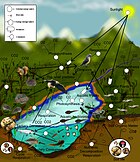
| Home | Sources Directory | News Releases | Calendar | Articles | | Contact | |
Ecological niche
In ecology, a niche (pronounced /ˈniːÊ�/ or /ˈnÉ�tÊ�/)[1] is a term describing the relational position of a species or population in its ecosystem to each other; e.g. a dolphin could potentially be in another ecological niche from one that travels in a different pod if the members of these pods utilize significantly different food resources and foraging methods.[1] A shorthand definition of niche is how an organism makes a living. The ecological niche describes how an organism or population responds to the distribution of resources and competitors (e.g., by growing when resources are abundant, and when predators, parasites and pathogens are scarce) and how it in turn alters those same factors (e.g., limiting access to resources by other organisms, acting as a food source for predators and a consumer of prey).[2]
Contents |
[edit] Parameters
The different dimensions, or plot axes, of a niche represent different biotic and abiotic variables. These factors may include descriptions of the organism's life history, habitat, trophic position (place in the food chain), and geographic range. According to the competitive exclusion principle, no two species can occupy the same niche in the same environment for a long time[3].
The word "niche" is derived from the Middle French word nicher, meaning to nest. The term was coined by the naturalist Joseph Grinnell in 1917, in his paper "The niche relationships of the California Thrasher."[4] However, it was not until 1927 that Charles Sutherland Elton, a British ecologist, gave the first working definition of the niche concept. He is credited with saying: "[W]hen an ecologist says 'there goes a badger,' he should include in his thoughts some definite idea of the animal's place in the community to which it belongs, just as if he had said, 'there goes the vicar.'"[5]
The niche concept was popularized by the zoologist G. Evelyn Hutchinson in 1957[6]. Hutchinson wanted to know why there are so many different types of organisms in any one habitat.
The full range of environmental conditions (biological and physical) under which an organism can exist describes its fundamental niche. As a result of pressure from, and interactions with, other organisms (e.g. superior competitors), species are usually forced to occupy a niche that is narrower than this, and to which they are mostly highly adapted. This is termed the realized niche. The ecological niche has also been termed by G.E. Hutchinson a "hypervolume." This term defines the multi-dimensional space of resources (e.g., light, nutrients, structure, etc.) available to (and specifically used by) organisms. The term adaptive zone was coined by the paleontologist, George Gaylord Simpson, and refers to a set of ecological niches that may be occupied by a group of species that exploit the same resources in a similar manner. (Simpson, 1944; After Root, 1967.)[citation needed]
Hutchinson's "niche" (a description of the ecological space occupied by a species) is subtly different from the "niche" as defined by Grinnell (an ecological role, that may or may not be actually filled by a species'see vacant niches).
Different species can hold similar niches and the same species may occupy different niches. The Australian grasslands species, though different from those of the Great Plains grasslands, occupy the same niche.[7]
Once a niche is left vacant, other organisms can fill that position. For example, the niche that was left vacant by the extinction of the tarpan has been filled by other animals (in particular a small horse breed, the konik). Also, when plants and animals are introduced into a new environment, they have the potential to occupy or invade the niche or niches of native organisms, often outcompeting the indigenous species. Introduction of non-indigenous species to non-native habitats by humans often results in biological pollution by the exotic or invasive species.
The mathematical representation of a species' fundamental niche in ecological space, and its subsequent projection back into geographic space, is the domain of niche modelling.
[edit] See also
- Environmental niche modelling
- Fitness landscape
- Habitat (ecology)
- Niche differentiation
- Overpopulation in wild animals
[edit] References
- ^ a b "Definition of niche - Merriam-Webster Online Dictionary". http://www.m-w.com/dictionary/niche. Retrieved 2007-07-26.
- ^ Lomolino, Mark V.; Brown, James W. (1998). Biogeography. Sunderland, Mass: Sinauer Associates. ISBN 0-87893-073-6.
- ^ Hardin, G. (1960). The Competitive Exclusion Principle. Science 131, 1292-1297.
- ^ Grinnell, J. (1917). "The niche-relationships of the California Thrasher". Auk 34: 427'433.
- ^ Elton, C.S. (2001). Animal Ecology. University of Chicago Press. ISBN 0226206394. http://books.google.com/?id=lZvgTuB9Gh4C&dq=editions:ISBN0226206394.
- ^ Hutchinson, G.E. (1957). "Concluding remarks" (PDF). Cold Spring Harbor Symposia on Quantitative Biology 22 (2): 415'427. http://artifex.org/~ecoreaders/lit/Hutchinson1957.pdf. Retrieved 2007-07-24.
- ^ Glossary for the Nature of Alberta
[edit] External links
- Concept of ecological niche
- Environmental Niche - Extinction of the Dinosaurs
- Ontology of the niche
- Niche restriction and segregation
- Vacant niche
- Latitude-niche width hypothesis
|
SOURCES.COM is an online portal and directory for journalists, news media, researchers and anyone seeking experts, spokespersons, and reliable information resources. Use SOURCES.COM to find experts, media contacts, news releases, background information, scientists, officials, speakers, newsmakers, spokespeople, talk show guests, story ideas, research studies, databases, universities, associations and NGOs, businesses, government spokespeople. Indexing and search applications by Ulli Diemer and Chris DeFreitas.
For information about being included in SOURCES as a expert or spokesperson see the FAQ . For partnerships, content and applications, and domain name opportunities contact us.

